- Home
- Technical Cooperation Projects
- Index of Countries
- Middle East
- Egypt
- Project for Strengthening Water Management Transfer
- Project News
- Technical Exchange Program was implemented with Vietnam Academy for Water Resources (VAWR) in Vietnam.
Project News
2015-10-18
Technical Exchange Program was implemented with Vietnam Academy for Water Resources (VAWR) in Vietnam.
Members of Project for Strengthening Water Management Transfer (SWMT Project) visited the Vietnam Academy for Water Resources (VAWR) to implement a Technical Exchange Program (TEP) on Participatory Irrigation Management (PIM) and Water Management Transfer (WMT) from October 3 to 10, 2015.
In Vietnam, verification of methodologies and establishment of a training system on PIM had been done through implementation of two technical cooperation projects of JICA called "Capacity Development of Participatory Irrigation Management System through Vietnam Institute for Water Resources Research (VIWRR) for Improvement of Agricultural Productivity" and "Project for Promotion of Participatory Irrigation Management for Sustainable Small-Scale Pro-Poor Infrastructure Development" of which the main counterpart (CP) was the VAWR since 2005.
Although the two projects were completed in 2013, the Vietnamese government is still working on developing the PIM.
The VAWR is a research institution under the Ministry of Agriculture and Rural Development of Vietnam which plays roles even as a consulting agency in developing and utilizing methods and technologies of irrigation and agriculture. In the VAWR, the PIM Center was established when the two projects above were started, while many CPs were positioned for the two projects.
In this TEP, three CPs of the Central Department of Irrigation Advisory Service (CDIAS) and one CP of each General Directorate of Irrigation Advisory Service (GDIAS) in Middle and West Delta, participated from Egypt with Eng. Kunihiko Naito, Chief Advisor of the SWMT Project.
They participated in a seminar at the VAWR to exchange and share information about their daily activities for two days as well as a field visit to Yen Dong District which was a pilot site of the two projects above.
The program of the TEP was planned and implemented so that all the participants of both Egypt and Vietnam can exchange information and know-how on their activities which are useful for development of PIM and WMT and effectively utilize them in their daily activities.
Therefore, the program focused on practical themes including lessons learnt and know-how to involve farmers and relevant stakeholders in the projects. Additionally it included ideal roles and responsibilities of the central and regional governments and the Water Users' Associations (WUAs) and the strategies for the dissemination of PIM.
On October 5, the six participants from Egypt firstly visited the JICA Vietnam Office and had a seminar with the VAWR. In the seminar, there were presentations by participants from the two countries on systems of water management, activities on PIM, WMT and their projects as well as Q&A at the end.
In Vietnam, both the Irrigation Management Company (IMC) under Provincial Government and the Irrigation Management Enterprise (IME) under District Government are in charge of operation and maintenance (O&M) of main and branch canals, whereas the PIM has been promoted for O&M of tertiary canals whose lengths and beneficial areas correspond to the ones of branch canals in Egypt.
As for WUAs in Vietnam, there are several different types including Agricultural Cooperative (APC) which is originally from Cooperative Society being in charge of irrigation service and WUAs which specialize in irrigation service.
So far many projects on PIM have been implemented by different donors, but the outcomes of most of them were not sustained after the end of the projects in both of Vietnam and Egypt. In this context, it was agreed in the seminar by the participants that sustainability of the project activities needs to be fully considered during the implementation of their technical cooperation projects all the time from the beginning.
Moreover, the Vietnamese participants explained that their government has been positively supporting them in promoting the PIM and that legal arrangement is important for that purpose.
On October 6 and 7, the participants visited Yen Lap IMC being in charge of Yen Dong district which was one of the pilot sites for the technical cooperation project of JICA mentioned above, as well as Yen Dong APC which also works as a WUA. During the visit, the participants exchanged information and opinions about their activities.
It was explained that IME which is a branch office of Yen Lap IMC and Yen Dong APC have a monthly meeting altogether[1] to periodically monitor the situations of water distribution and irrigation facilities, while they are smoothly coping with any problem by clarifying their roles and responsibilities.
In addition, it was also explained that Provincial People's Committee (PPC) of Quang Ninh Province implements a field survey on irrigation services to farmers to monitor activities by both IMC and APC.
Moreover, a staff of Yen Dong APC explained that the canals were constructed with farmers who were motivated enough to participate in that activity by the fact that their actual harvests had been increased by the project. In addition, it was also explained that almost all farmers attend the monthly meetings by the IME as well as the periodical general assembly, whereas expenses on daily water management are covered with fees of 7US$/ha/year for use of water paid by every farmer.
In a seminar with the VAWR on October 8, the Egyptian team made presentations about the project activities in the pilot sites, evaluation system on Branch Canal Water Users' Associations (BCWUAs) and current activities on nationwide expansion of WMT. On the other hand, the Vietnamese team introduced their activities on modernization of the irrigation sector by a project of the World Bank. Thereafter, opinions about those presentations were exchanged by all the participants as follows.
After the seminar, the Egyptian participants had several comments like; "I thought that there is a good system in Vietnam ranging from the central to the district levels to fully support farmers in implementing the PIM."
"Since the APC plays a role of WUA in Vietnam, it can allow them to effectively coordinate two plans of agriculture and water distribution. In Egypt, although IAS has its mission to coordinate those plans with the other departments and organizations, it is very challenging at this moment."
"I thought that having a monthly meeting between the IME and the APC is a key-point to keep their activities sustainable. After going back to Egypt, I would like to follow up board-meetings and general assemblies more carefully to make their activities more meaningful."
I believe that it was very meaningful for all the participants to implement the TEP because they could exchange and share information and opinions about their project activities.
We deeply felt that there is a lot of common know-how to promote the PIM and the WMT even if the two countries have different natural and social conditions.
I think that all the participants could get confidence in implementing their current activities from the TEP. Especially, it was very useful for the Egyptian participants to see and learn that there is a good system from the central to the district levels to support and implement the PIM in Vietnam since they could have clear image about their daily work in the future.
Finally, I cordially thank the VAWR very much for their full support to implement the TEP. I wish all the participants will play important roles in implementing the PIM and the WMT in each of the two countries by utilizing what they learned in the TEP.
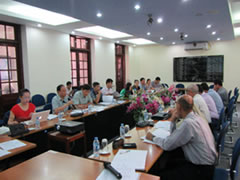 Seminar at the VAWR
Seminar at the VAWR
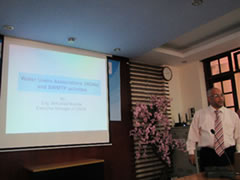 Presentation by Eng. Mokhtar, CDIAS
Presentation by Eng. Mokhtar, CDIAS
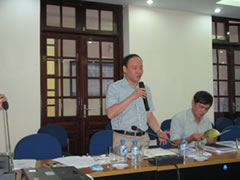 Dr. Phong as a MC of the seminar
Dr. Phong as a MC of the seminar
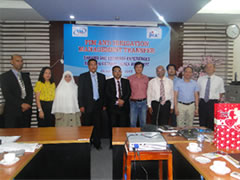 Group photo after the seminar
Group photo after the seminar
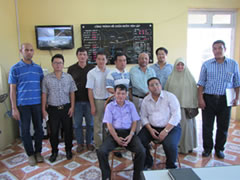 Group photo after the meeting at the Yen Lap IMC
Group photo after the meeting at the Yen Lap IMC
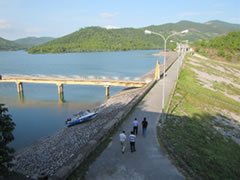 Yen Lap Dam, Water Source in Yen Dong district
Yen Lap Dam, Water Source in Yen Dong district
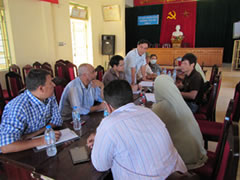 Meeting with Yen Dong APC
Meeting with Yen Dong APC
Note
- [1] The meeting is held more frequently in the season of irrigation.
- About JICA
- News & Features
- Countries & Regions
- Our Work
- Thematic Issues
- Types of Assistance
- Partnerships with Other Development Partners
- Climate Change / Environmental and Social Considerations
- Evaluations
- Compliance and Anti-corruption
- Science and Technology Cooperation on Global Issues
- Research
- JICA Development Studies Program / JICA Chair
- Support for the Acceptance of Foreign HRs / Multicultural and Inclusive Community
- Publications
- Investor Relations
